
Intellivision - Intelligent Television
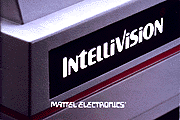


Like most new systems, Intellivision initially suffered from a very small game library. All the titles avaiable when the system was released were developed under contract for Mattel by an outside company. However, when demand soared, it was clear to Mattel that by setting up their own in-house developement group they could realize higher profits on software sales. So they set about recruiting many of the country's brightest and most promising programmers to develop games for the Intellivision. Seized by the paranoia that Atari would try to steal away much of this talent (a fear that was probably quite justified), Mattel kept everything about the group completely secret. They named the developement team the Blue Sky Rangers. Names of programmers and where the team worked was never discussed publicly, even though which software titles were under developement was often common knowledge.
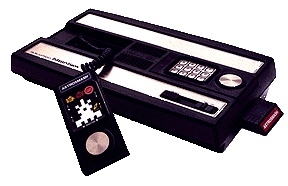
Mattel manufactured 5 different models of the Intellivision. The original model (pictured above) featured dark brown plastic housing with gold-colored metal accent panels and hard wired controllers. Two of the re-badged models were very similair. In the case of the Tandyvision model, the gold panels were repleaced with fake wood grain panels. The Sylvania model (which is rather rare) also had differences that were only cosmetic. The Sears model had controllers that could be unplugged, allowing for easy replacement. The system's sports title's had a weakness of being 2-player only, with no vs.CPU mode. The pack-in cartridge was "Las Vegas Poker and Blackjack".
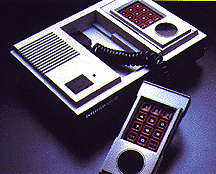
Later, Mattel introduced the Intellivision II (shown above), which was smaller, sleeker, cheaper, and also featured removable controllers. There were also minor changes to the system to allow for the "System Changer" - a 2600 adapter, as well as a new EXEC ROM which was designed to hamper unauthorized third party developement.
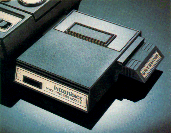
The Intellivision line also had an interesting selection of peripherals. This was the first system to market a voice module, known as the Intellivoice (pictured above). It was also the first system to actually release a computer upgrade unit Entertainment Computer System, or ECS. There was also a full-sized music keyboard which could be plugged into the ECS computer module, as well as the fore-mentioned "System Changer". (The System Changer ONLY worked with the Intellivision II console.)
When the ColecoVision and later the Atari 5200 were introduced, it was clear Mattel would lose their claim to being the most "realistic" game system. So Mattel began developing not one but two successors to the Intellivision. One of these, the Intellivision III, was shown to the press not long before the crash. The 'III' could probably have been a contender had it not suffered from "feature creep" (also known as Kitchen Sink Syndrome, as in everything but) in the R&D labs. The unit was originally intended to be merely a standard Intellivision with a beefed up video chip and a second sound ship (to boost the number of sound channels available). As a result, it was compatible with old games, had improved sound and graphics, and ran faster than the old machine. Features that creeped in were wireless controllers, support for 4 controllers, and Intellivoice hardware built in. The constant addition of such new features forced the constant re-writing of the EXEC ROM (the unit's operating system). As a result, the machine stayed in developement far too long, and was still not ready for production when the crash hit. The other unit, known informally as the Intellivision 4, was under developement seperate from the main lab, and without their knowledge, for fear that once again too many cooks would spoil the brew. Developement was in its infancy when Mattel Electronics was shut down, and very little is known about this machine.
After the demise of Mattel Electronics, a new company was formed called INTV. Comprised of former Mattel Electronics employees, this company bought the entire Intellivision program from Mattel. (Having lost millions in the crash, Mattel was eager to unload what remained - even at bargain basement prices.) Their entire inventory of hardware and game cartridges, as well as software code, patents, schematics, even projects never completed. The company began republishing many of the old Intellivision titles, dumping licenses to save money. For instance, "NFL Football" became "Super Pro Football". They also began making their own Intellivision console, dubbed the INTV System III (was also known as the Super Pro System). The System III unit should not be confused with the Intellivision III that was being developed by Mattel Electronics before shutting down. A version of this unit was later promised by INTV, but by that time the company lacked the financial resources to finish Mattel's project.
Besides republishing (and in some cases, rewriting) Mattel's games, they also wrote several new games, as well as digging up games from other makers. INTV re-issues are easy to spot by their white labels with black lettering, and the marking "ŠII". INTV versions are generally rarer than the original versions, particularly in the case of former Mattel titles. This is because much of INTV's sales were made via mail order.
There were two models manufactured by INTV. The only difference between them was the name on the console - "System III" or "Super Pro System". They were virtually identical to the original Intellivision model. The unit was housed in black plastic with silver accents, and featured a power LED between the power switch and the reset button. The controllers were hard wired to cut costs. INTV did not manufacture any Intellivision peripherals and continued to stay in business clear up until 1991.
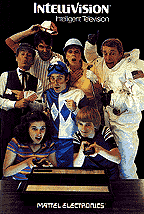
Want to find out more? Try the Intellivision FAQ
Created: 21 Oct 1997
Last updated: 10 Nov 1997